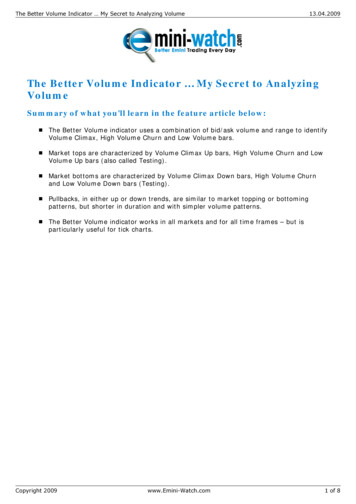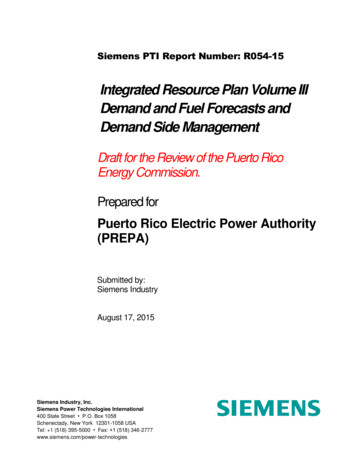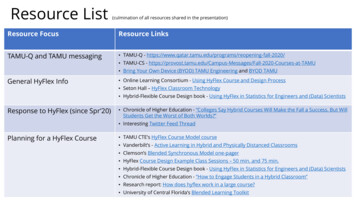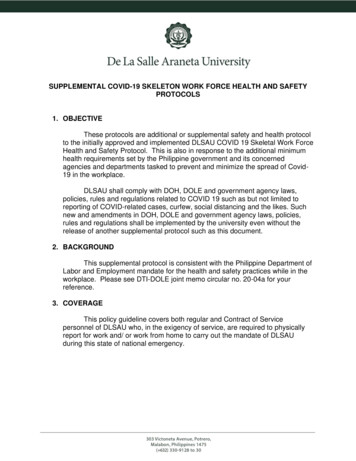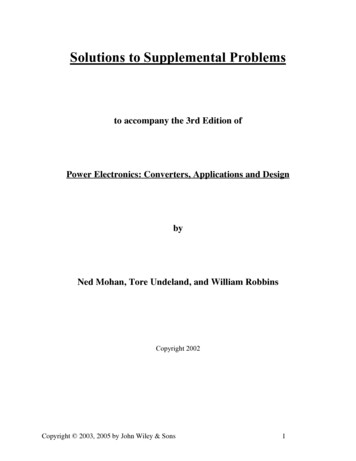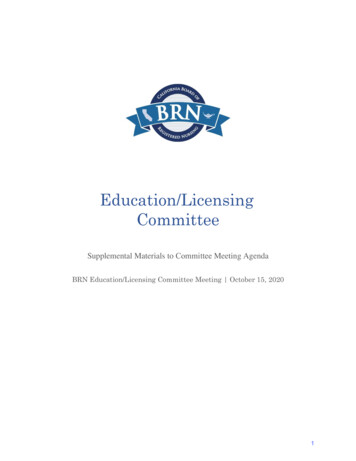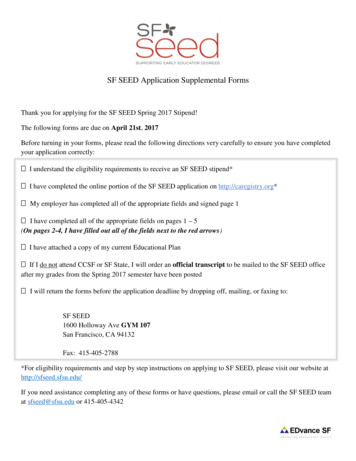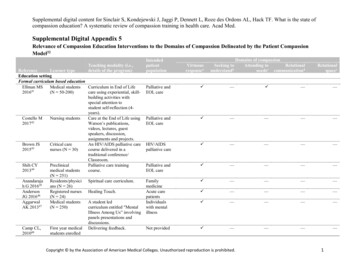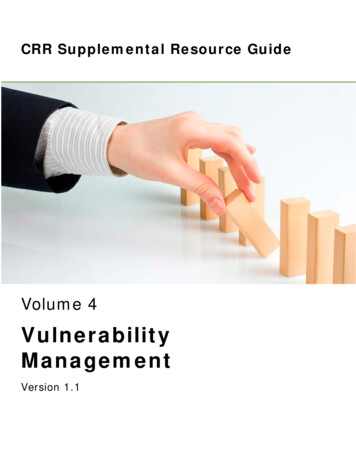
Transcription
CRR Supplemental Resource GuideVolume 4VulnerabilityManagementVersion 1.1
Copyright 2016 Carnegie Mellon UniversityThis material is based upon work funded and supported by Department of Homeland Security under ContractNo. FA8721-05-C-0003 with Carnegie Mellon University for the operation of the Software EngineeringInstitute, a federally funded research and development center sponsored by the United States Department ofDefense.Any opinions, findings and conclusions or recommendations expressed in this material are those of theauthor(s) and do not necessarily reflect the views of Department of Homeland Security or the United StatesDepartment of Defense.NO WARRANTY. THIS CARNEGIE MELLON UNIVERSITY AND SOFTWARE ENGINEERINGINSTITUTE MATERIAL IS FURNISHED ON AN “AS-IS” BASIS. CARNEGIE MELLON UNIVERSITYMAKES NO WARRANTIES OF ANY KIND, EITHER EXPRESSED OR IMPLIED, AS TO ANYMATTER INCLUDING, BUT NOT LIMITED TO, WARRANTY OF FITNESS FOR PURPOSE ORMERCHANTABILITY, EXCLUSIVITY, OR RESULTS OBTAINED FROM USE OF THE MATERIAL.CARNEGIE MELLON UNIVERSITY DOES NOT MAKE ANY WARRANTY OF ANY KIND WITHRESPECT TO FREEDOM FROM PATENT, TRADEMARK, OR COPYRIGHT INFRINGEMENT.[Distribution Statement A] This material has been approved for public release and unlimited distribution.Please see Copyright notice for non-US Government use and distribution.CERT and OCTAVE are registered marks of Carnegie Mellon University.DM-0003278Distribution Statement A: Approved for Public Release; Distribution is Unlimited
Table of ContentsI. Introduction . 1Series Welcome .1Audience .3II. Vulnerability Management . 4Overview .4Define a Vulnerability Analysis and Resolution Strategy.5Develop a Plan for Vulnerability Management .5Implement the Vulnerability Analysis and Resolution Capability .6Assess and Improve the Capability.6III. Define a Vulnerability Analysis and Resolution Strategy . 7Before You Begin .7Step 1. Determine the scope of vulnerability management. .7Step 2. Determine approved methods of vulnerability assessment. .8Step 3. Resource the activities. .9Output of Section III . 10IV. Develop a Plan for Vulnerability Management . 11Before You Begin . 11Step 1. Define and document the plan. . 11Step 2. Define measures of effectiveness. 13Step 3. Define training requirements. . 13Step 4. Determine tools aligned to the strategy. . 14Step 5. Identify sources of vulnerability information. . 14Step 6. Define the roles and responsibilities. . 16Step 7. Engage stakeholders. . 16Step 8. Develop a plan revision process. . 17Output of Section IV . 18V. Implement the Vulnerability Analysis and Resolution Capability . 19Before You Begin . 19Step 1. Provide training. 19Step 2. Conduct vulnerability assessment activities. . 20Step 3. Record discovered vulnerabilities. . 20Step 4. Categorize and prioritize vulnerabilities. . 21Step 5. Manage exposure to discovered vulnerabilities. . 22Step 6. Determine effectiveness of vulnerability dispositions. 24Step 7. Analyze root causes. . 25Output of Section V . 26VI. Assess and Improve the Capability . 27Before You Begin . 27Distribution Statement A: Approved for Public Release; Distribution is Unlimited
Step 1. Determine the state of the program. . 27Step 2. Collect and analyze program information. . 28Step 3. Improve the capability. 28Output of Section VI . 29VII. Conclusion . 30Appendix A. Vulnerability Management Resources. 31Appendix B. CRR/CERT-RMM Practice/NIST CSF Subcategory Reference . 34Endnotes . 36Distribution Statement A: Approved for Public Release; Distribution is Unlimited
I. IntroductionSeries WelcomeWelcome to the CRR Resource Guide series. This document is one of 10 resource guides developed by theDepartment of Homeland Security’s (DHS) Cyber Security Evaluation Program (CSEP) to help organizationsimplement practices identified as considerations for improvement during a Cyber Resilience Review (CRR). 1The CRR is an interview-based assessment that captures an understanding and qualitative measurement of anorganization’s operational resilience, specific to IT operations. Operational resilience is the organization’sability to adapt to risk that affects its core operational capacities. 2 It also highlights the organization’s ability tomanage operational risks to critical services and associated assets during normal operations and during times ofoperational stress and crisis. The guides were developed for organizations that have participated in a CRR, butany organization interested in implementing or maturing operational resilience capabilities for critical ITservices will find these guides useful.The 10 domains covered by the CRR Resource Guide series are1. Asset Management2. Controls Management3. Configuration and Change Management4. Vulnerability Management This guide5. Incident Management6. Service Continuity Management7. Risk Management8. External Dependencies Management9. Training and Awareness10. Situational AwarenessThe objective of the CRR is to allow organizations to measure the performance of fundamental cyber securitypractices. DHS introduced the CRR in 2011. In 2014, DHS launched the Critical Infrastructure CyberCommunity or C³ (pronounced “C Cubed”) Voluntary Program to assist the enhancement of criticalinfrastructure cybersecurity and to encourage the adoption of the National Institute of Standards andTechnology’s (NIST) Cybersecurity Framework (CSF). The NIST CSF provides a common taxonomy andmechanism for organizations to1. describe their current cybersecurity posture2. describe their target state for cybersecurity3. identify and prioritize opportunities for improvement within the context of a continuous andrepeatable process4. assess progress toward the target state5. communicate among internal and external stakeholders about cybersecurity riskDistribution Statement A: Approved for Public Release; Distribution is Unlimited1
The CRR Self-Assessment Package includes a correlation of the practices measured in the CRR to criteria ofthe NIST CSF. An organization can use the output of the CRR to approximate its conformance with the NISTCSF. It is important to note that the CRR and NIST CSF are based on different catalogs of practice. As aresult, an organization’s fulfillment of CRR practices and capabilities may fall short of, or exceed,corresponding practices and capabilities in the NIST CSF.Each resource guide in this series has the same basic structure, but each can be used independently. Each guidefocuses on the development of plans and artifacts that support the implementation and execution of operationalresilience capabilities. Organizations using more than one resource guide will be able to leveragecomplementary materials and suggestions to optimize their adoption approach. For example, this guidedescribes the process of performing a focused and defined vulnerability management process. Thedevelopment of this process can be informed by the information learned and developed in a controlsmanagement process. The outputs of the vulnerability process are key components of a risk managementprocess.Each guide derives its information from best practices described in a number of sources, but primarily from theCERT 1 Resilience Management Model (CERT -RMM). 3 The CERT-RMM is a maturity model formanaging and improving operational resilience, developed by the CERT Division of Carnegie MellonUniversity’s Software Engineering Institute (SEI). This model is meant to guide the implementation and management of operational resilience activities converge key operational risk management activities define maturity through capability levels enable maturity measurement against the model improve an organization’s confidence in its response to operational stress and crisisThe CERT-RMM provides the framework from which the CRR is derived—in other words, the CRR methodbases its goals and practices on the CERT-RMM process areas.This guide is intended for organizations seeking help in establishing a vulnerability management process. Theprocess areas described include developing a vulnerability analysis and resolution strategy developing a vulnerability management plan developing a vulnerability discovery capability assessing the vulnerability management activities managing exposureMore specifically this guide educates and informs readers about the vulnerability management process promotes a common understanding of the need for a vulnerability management process identifies and describes key practices for vulnerability analysis and resolution and vulnerabilitymanagement provides exa
development of this process can be informed by the information learned and developed in a controls management process. The outputs of the vulnerability process are key components of a risk management process. Each guide derives its information from best practices described in a number of sources, but primarily from the CERT 1. Resilience Management Model (CERT -RMM). 3. The CERT-RMM is a


